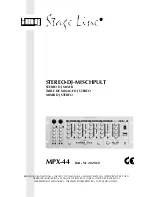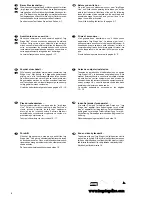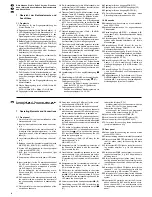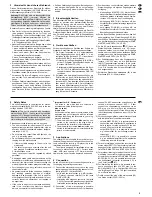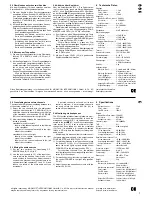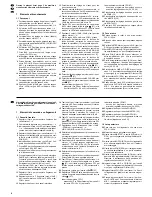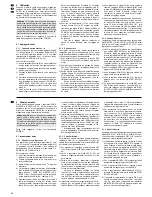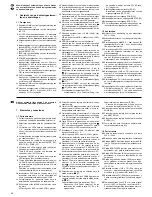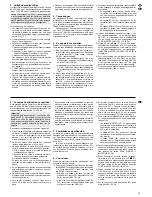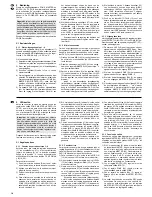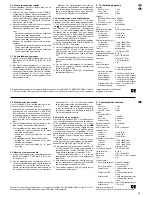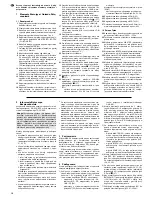
5
Bedienung
Vor dem Einschalten die Ausgangsregler ZONE,
MASTER und BOOTH (24, 25, 26) auf Minimum
stellen, um Einschaltgeräusche zu vermeiden. Das
Mischpult mit dem Schalter POWER (8) einschalten.
Die Betriebsanzeige über dem Schalter leuchtet.
Nach dem Betrieb das Mischpult wieder mit dem
Schalter POWER ausschalten.
5.1 Grundeinstellungen
5.1.1 Stereo-Eingangskanäle 1 – 4
Vorab alle Gain-Regler (1) und Klangregler (17) so-
wie den Balanceregler (5) in die Mittelposition dre-
hen. Die zwei Zuordnungsschalter für die Über-
blendfunktion C.F. ASSIGN A und B (18, 20) auf „0“
stellen.
Zum Aussteuern eines Kanals:
1) Mit dem Eingangsumschalter (2) des Kanals die
Buchsen der gewünschten Signalquelle anwäh-
len.
2) Ein Tonsignal (z. B. Musikstück) auf den Eingang
geben.
3) Den Fader (4) des Kanals bis ca.
2
/
3
des Maxi-
mums aufziehen.
4) Um das Signal über die Lautsprecher einer ange-
schlossenen PA-Anlage abzuhören, den jeweili-
gen Ausgangsregler – ZONE (24), MASTER (25)
oder BOOTH (26) – aufdrehen. (Das Signal lässt
sich auch über einen Kopfhörer abhören – siehe
dazu Kap. 5.4.)
5) Die Kanal-Pegelanzeige (3) zeigt den Signal-
pegel vor dem Kanalfader (Pre-Fader-Pegel) an.
Anhand der Pegelanzeige mit dem Gain-Regler
(1) des Kanals den Eingang aussteuern: Opti-
male Aussteuerung liegt vor, wenn bei durch-
schnittlich lauten Passagen Werte im 0-dB-Be-
reich angezeigt werden. Leuchtet die rote +9-dB-
LED auf, ist der Kanal übersteuert. Falls erforder-
lich, kann der Gain-Regler auch ganz auf MIN
bzw. MAX gedreht werden.
6) Mit den drei Klangreglern (17) des Kanals das
gewünschte Klangbild einstellen. Durch Verstel-
len der Regler lassen sich die Höhen (HIGH),
Mitten (MID) und Bässe (LOW) anheben (bis
max. 15 dB) bzw. stark absenken (bis max.
30 dB). Stehen die Regler in Mittelstellung, findet
keine Frequenzgangbeeinflussung statt.
Eventuell muss nach der Klangeinstellung der
Kanalpegel noch einmal mit dem Gain-Regler
korrigiert werden.
5.1.2 Mikrofonkanäle
Zum Aussteuern eines Mikrofonkanals vorab den
Gain-Regler (11) und die Klangregler (12) des
Kanals in die Mittelposition und den Schalter PAD
(10) des Kanals in die obere Position stellen.
1) Zum Einschalten des Mikrofons die Taste MIC
ON (14) des Kanals drücken (LED über der Taste
leuchtet).
2) Den Pegelregler LEVEL (13) des Kanals und den
Masterregler (25) bis ca.
2
/
3
des Maximums auf-
drehen.
3) In das Mikrofon sprechen. Den Gain-Regler (11)
des Kanals so einstellen, dass die Stereo-Pegel-
anzeige (6) Werte im 0-dB-Bereich anzeigt (der
Regler kann ggf. auch ganz zu- oder aufgedreht
werden).
Tritt eine akustische Rückkopplung auf (lauter
Pfeifton) oder ist der Eingangspegel auch bei
zugedrehtem Gain-Regler noch zu hoch, den
PAD-Schalter (10) des Kanals in die untere Posi-
tion schieben: Der Eingangspegel wird dann um
15 dB abgesenkt.
4) Den Klang mit der 3fachen Klangregelung (12) des
Kanals einstellen: die Höhen (HIGH), Mitten (MID)
und Bässe (LOW) lassen sich bis max. 12 dB an-
heben oder absenken. Eventuell danach den
Kanalpegel mit dem Gain-Regler korrigieren.
5) Zur besseren Verständlichkeit einer Durchsage
bei laufendem Musikprogramm kann für das DJ-
Mikrofon mit der Taste AUTO TALK (15) die Talk-
over-Funktion eingeschaltet werden: Ist die Taste
gedrückt (LED darüber leuchtet), werden bei
Durchsagen über das DJ-Mikrofon die Pegel der
Stereo-Kanäle 1 – 4 automatisch um 16 dB ab-
gesenkt. Zum Abschalten der Funktion die Taste
wieder ausrasten.
5.1.3 Ausgangskanäle
Das Ausgangssignal wird auf die regelbaren Aus-
gänge MASTER (30), BOOTH (31) und ZONE (32)
sowie auf den Aufnahmeausgang REC (33) – ohne
eigenen Pegelregler – gegeben.
1) Die Stereo-Pegelanzeige (6) zeigt den Pegel des
Signals an den Ausgängen MASTER an. Den
Pegel anhand der Pegelanzeige mit dem Regler
MASTER (25) optimal aussteuern. In der Regel
wird eine optimale Aussteuerung erreicht, wenn
die Pegelanzeige Werte im 0-dB-Bereich anzeigt.
Ist der Ausgangspegel jedoch für das nachfol-
gende Gerät zu hoch oder zu niedrig, muss das
Signal entsprechend niedriger oder höher ausge-
steuert werden.
2) Mit dem Regler BOOTH (26) den gewünschten
Signalpegel für den Ausgang BOOTH einstellen.
3) Mit dem Regler ZONE (24) den gewünschten
Signalpegel für den Ausgang ZONE einstellen.
4) Mit dem Balanceregler BAL (5) die Balance für
die Ausgänge MASTER, BOOTH und ZONE ein-
stellen.
5) Das Aufnahmesignal am Ausgang REC kann
über Kopfhörer abgehört werden – siehe dazu
Kap. 5.4. Es wird nicht von den Reglern MAS-
TER, BOOTH und ZONE beeinflusst (Signalab-
griffspunkt vor den Ausgangsreglern).
Vorsicht! Stellen Sie die Lautstärke der Audioan-
lage und die Kopfhörerlautstärke nie sehr hoch ein.
Hohe Lautstärken können auf Dauer das Gehör
schädigen! Das menschliche Ohr gewöhnt sich an
große Lautstärken und empfindet sie nach einiger
Zeit als nicht mehr so hoch. Darum eine hohe Laut-
stärke nach der Gewöhnung nicht weiter erhöhen.
5
Operation
Prior to switching on, set the output controls ZONE,
MASTER, and BOOTH (24, 25, 26) to minimum to
prevent switching noise. Switch on the mixer with
the switch POWER (8). The power LED above the
switch lights up.
After operation, switch off the mixer with the switch
POWER.
5.1 Basic adjustments
5.1.1 Stereo input channels 1 to 4
First set all gain controls (1), equalizer controls (17),
and the balance control (5) to mid-position. Then set
the two switches for crossfading C.F. ASSIGN A and
B (18, 20) to “0”.
Level control of a channel:
1) Use the input selector switch (2) of the channel to
select the jacks of the desired signal source.
2) Feed an audio signal (e. g. music piece) to the
input.
3) Advance the fader (4) of the channel to approx.
2
/
3
of its maximum.
4) To monitor the signal via the speakers of a PA
system connected, advance the corresponding
output control – ZONE (24), MASTER (25) or
BOOTH (26). [The signal can also be monitored
via headphones – see chapter 5.4.]
5) The level indication (3) of the channel displays
the signal level ahead of the channel fader (pre-
fader level). Via the level indication, control the
level of the input with the gain control (1) of the
channel: In case of optimum level control, values
in the 0 dB range are displayed at average vol-
ume. If the red +9 dB LED lights up, there is an
overload of the channel. If required, turn the gain
control fully to MIN or MAX.
6) Adjust the desired sound with the three equalizer
controls (17) of the channel. By adjusting the
controls, the high frequencies (HIGH), midrange
frequencies (MID), and low frequencies (LOW)
can be boosted (up to 15 dB max.) or substan-
tially attenuated (up to 30 dB max.). With the con-
trols in mid-position, the frequency response is
not affected.
After the sound adjustment, readjust the
channel level once again with the gain control, if
required.
5.1.2 Microphone channels
For level control of a microphone channel, first set
the gain control (11) and the tone controls (12) of the
channel to mid-position and set the switch PAD (10)
of the channel to the upper position.
1) To switch on the microphone, press the button
MIC ON (14) of the channel (LED above the but-
ton lights up).
2) Advance the control LEVEL (13) of the channel
and the master control (25) to approx.
2
/
3
of its
maximum.
3) Speak into the microphone. Adjust the gain con-
trol (11) of the channel in such a way that the ste-
reo level indication (6) displays values in the 0 dB
range (if required, the control can be fully opened
or closed).
In case of howlback (loud whistling) or if the
input level is too high even with the gain control
closed, set the PAD switch (10) of the channel to
the lower position: The input level will be attenu-
ated by 15 dB.
4) Adjust the sound with the 3-way tone control (12)
of the channel: the high frequencies (HIGH) mid-
range frequencies (MID) and low frequencies
(LOW) can be attenuated or boosted up to 12 dB
max. Readjust the channel level with the gain
control afterwards, if required.
5) To improve the audibility of an announcement
during the current music programme, the talkover
function can be switched on for the DJ micro-
phone with the button AUTO TALK (15): With the
button pressed (LED above it lights up), the
levels of the stereo channels 1 to 4 are automati-
cally attenuated by 16 dB when announcements
are made via the DJ microphone. To switch off
the function, unlock the button.
5.1.3 Output channels
The output signal is fed to the adjustable outputs
MASTER (30), BOOTH (31), ZONE (32) and to the
recording output REC (33) without individual level
control.
1) The stereo level indication (6) displays the level
of the signal at the outputs MASTER. Via the
level indication, adjust an optimum level with the
control MASTER (25). Usually, an optimum level
is obtained if the level indication displays values
in the 0 dB range. However, if the output level is
too high or too low for the following unit, the sig-
nal must be controlled to a correspondingly lower
or higher level.
2) With the control BOOTH (26), adjust the desired
signal level for the output BOOTH.
3) With the control ZONE (24), adjust the desired
signal level for the output ZONE.
4) With the balance control BAL (5), adjust the
balance for the outputs MASTER, BOOTH, and
ZONE.
5) The recording signal at the output REC can be
monitored via headphones – see chapter 5.4. It is
not affected by the controls MASTER, BOOTH,
and ZONE (the signal is taken off ahead of the
output controls).
Caution! Never adjust the audio system or the
headphones to a very high volume. Permanent
high volumes may damage your hearing! The
human ear will get accustomed to high volumes
which do not seem to be that high after some time.
Therefore, do not further increase a high volume
after getting used to it.
6
GB
D
A
CH

